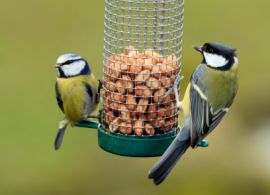 Bird feeding has become a year round hobby for many people. We have found that using a good quality bird seed allows our customers to see and feed more beautiful birds and puts less waste on the ground. Here are some suggestions on basic backyard bird feeding we learned from Bird Watcher’s and Rutgers’ Cook College Research and Extension.
Bird feeding has become a year round hobby for many people. We have found that using a good quality bird seed allows our customers to see and feed more beautiful birds and puts less waste on the ground. Here are some suggestions on basic backyard bird feeding we learned from Bird Watcher’s and Rutgers’ Cook College Research and Extension.
Create a habitat for bird feeding sections
Birds have three basic needs. They are shelter, food and water. Providing those needs in your backyard will increase a bird’s habitat. Thus, you will bring various bird species to your area. Creating a bird habitat will help you learn to care for them, forming a bond between you and your new friends.
Build a Bird Shelter
First, place a bird feeder in an area where it is protected from bird predators. Put your feeder in an isolated area, on a pole or a crane and have your feeder suspended in the air at least four feet off the ground. Put a squirrel baffle below your feeder so squirrels and raccoons cannot climb the pole to attack the feeder. In the isolated area, provide some shelter—small trees, small shrubbery, even stick some broken limbs in the ground so birds can escape from cats and hawks. Finally, place your feeder in an area with easy access.
Bird Food
Cleaning and refilling a bird feeder will help attract a large variety of birds. Focus on attracting small birds to your feeder. Black oil sunflower is a value seed that attracts the greatest variety of birds. The shell covering is soft so small birds will be able to pick it open and get the heart off the seed. A mixed bird seed blend with ingredients such as millet, crack corn, thistle and black oil sunflower will attract even a larger variety of birds. Birds such as morning doves, wrens and cardinals are attracted to the millet and cracked corn. Morning doves will eat millet on the ground.
Clean the bird feeding area from debris, leaves and old birdseed to prevent mold and mildew from accumulating. Birds will be discouraged from eating from your feeder if it is not clean. Once a week take a leaf rake and clean up most of the debris in the feeding section.
A type of bird seed known as sunflower hearts or kernels are sunflower seeds without their shells. The seed is considered 100% edible, thus less debris to clean up. Another seed option is thistle or Nyjer seed. Thistle seed attracts goldfinch, house finch and morning doves. If you use thistle feeders during the warmer months, maintenance to the feeder is a must. Clean the feeder with hot water and a tube brush to eliminate mold and debris.
Attract Birds with Water
Attracts more birds to your bird feeding station with water. Birds are attracted to shallow levels of water, one to two-inches of water in a bird bath located close to the ground is the most ideal situation for birds. Unfortunately, if cats are within the area, they will be near the watering stations. To prevent surprise attacks from cats, raise your birdbath to provide good visibility for quick escapes. Fill your birdbath with clean water and use a scrub brush to clean it every time it is refilled. Cleaning and commitment to constant refilling of water and food will attract the largest variety of birds.
In closing, providing a habitat for birds, shelter, food and water will attract a mixed variety of birds that will excite your new hobby of bird feeding. Expand on new ideas and receive expert tips from one of our NJ garden centers.
